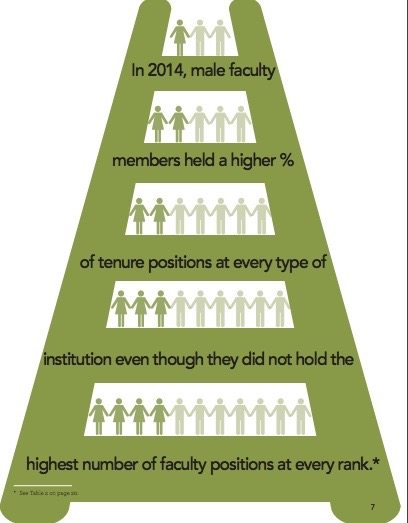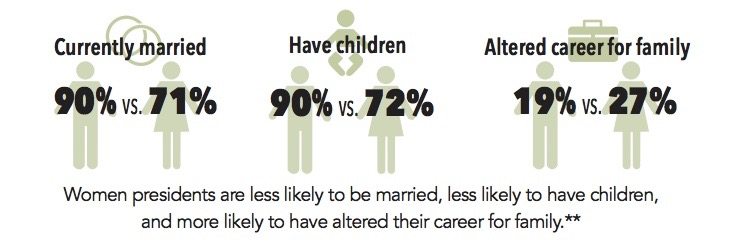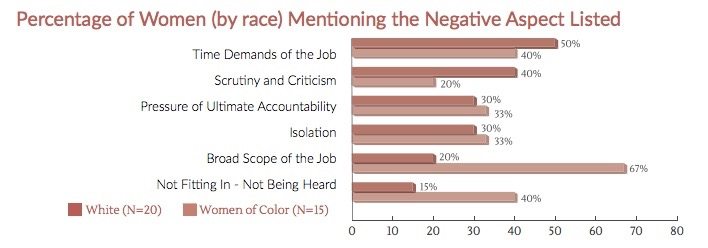Culture January 30, 2017


American universities are suffering from a presidential gender gap with only around one in four of them run by women.
For years, the world has struggled with the idea of women in leadership positions. The arguments vary, but the message is the same: equality is not quite here yet. That’s certainly true in academia.
While women are starting to enter the boys’ club that is often the university president position, their presence is statistically (and frighteningly) low. In fact, according the latest available study, women only hold 27 percent of university president positions.
Why is the number of female university presidents still so low? What changes can we expect or hope for in the future? ENTITY spoke to Molly Broad, President of the American Council on Education, and Judith S. White, President & Executive Director of HERS (an organization that provides leadership training for women in higher education), to find out.
Now, let’s take a short trip back to school for a statistics class. If you were told that a kindergarten class had 10 students – 6 girls, 4 boys – who scored high on an academic performance exam, what girl-boy ratio would you predict in the academically gifted first grade class? Most likely, something close to 50/50.
When it comes to earning college degrees, you should probably make the same prediction – but your conclusion would be wrong. Women have earned more than 50 percent of all associate degrees, master’s degrees, bachelor’s degrees and doctoral degrees respectively since 1978, 1991, 1981 and 2006. Yet, approximately 74% of university presidents are male. The “pipeline myth” – or the idea that there isn’t enough qualified women for the position – is often blamed for gender inequality in positions of power. However, as these stats show, there are plenty of talented, educated women – they just aren’t getting picked.


Via the 2016 Report by ACE Net
Frightening statistics appear when describing more than just female education levels and presidential seats. In 2014, men held more tenure positions at every kind of educational institution, even when there were more women holding faculty positions. Not only that, but men also out-earned women by $13,616 at public institutions and $17,843 at private institutions. All of this goes to say that women’s lower representation in presidential seats isn’t the only area of gender inequality at universities. Yet, as Molly Broad points out, “It is very clear that women are unrepresented in the presidential leadership positions and while the needle has been moving in the right direction, it is very slow. So you ask yourself, why is that the case?”
So why are so many presidents male when so many candidates are female? For Molly Broad, “unconscious bias” is one of the biggest barriers for women. “The fact that three out of four members of the boards of trustees on the boards of universities are men is probably a significant part of the explanation for why most of the presidents, even today, are men,” she explains. Presidents are usually selected out of the accomplished candidates within board members’ networks…and with fewer women on the board, there are likely fewer ties to qualified women.
READ MORE: The Magic of Mentorship: Meet Your Match
When asked about the barriers facing female university presidential candidates, Judith White pointed ENTITY to a recent report on higher education created by HERS. It states that women are also disadvantaged because “men are still viewed as ‘default leaders’ and women as ‘atypical leaders.'” Not to mention that the higher up a woman goes at work, the fewer female colleagues available as mentors or supervisors.
Female role models in the workplace are so important to mentor and nurture new talent.
— Mofe My Magnolia Sky (@mymagnoliasky) May 22, 2015
SS“We need more female mentors to mentor women; & although mentorship is important sponsorship is MORE important” @huadvanceit
— Womanity-Talk (@womanitytalk) November 30, 2015
Perhaps the figure most pivotal to a woman’s success in becoming a university president, though, is a sponsor. A sponsor is “someone who knows of your good work and can say, ‘Have you thought of this person? She is very very talented and has a lot of experience. I suggest you take a look at her,'” says Broad. Sponsors may be especially important for colored women; the report by HERS also found that 75 percent of colored female women experienced a “lack of opportunities and support” compared to only 35 percent of white women. When you have a sponsor, you can still by identified as a candidate for an open presidential position – whether or not you’re included within board members’ networks.
Sure, you may be qualified for the job as a university president. But to even be in the running, who you know is just as important as what you know.
If you were asked why women don’t hold as many powerful positions in society as men, what would you say? One of the most obvious – and most used – answers involves one word: babies. As you’ve seen in countless TV shows, books and even in your own life, women often have to choose between furthering their career or having children. Women who try to do both often step away from work for childbirth, which, according to Broad, pushed them to the “back of line” for promotions, like becoming a university president. Today, however, “more than 70 percent of all the instruction is being carried out by contingent [non-tenure] faculty,” says Broad. “Some of them teach one course and some of them teach a full load. [This shift in teaching structure] provides opportunities for women to develop their credibility and their skill in teaching and not have to do it on a full-time basis.”
READ MORE: 4 Different Teaching Styles Today
While it seems like part-time teaching positions are empowering women to be teachers as well as mothers, the family/work balance is still a struggle for female university presidents. According to a 2016 report, female university presidents are less likely than their male counterparts to be married or have children and are more likely to have “altered their career” for family. While people can choose to not have children for a variety of reasons, being “forced” to make that hard decision because of one’s job has its downfalls. In fact, research shows that leaders who also engage in parenting experience higher self-esteem and receive higher ratings of managerial skill and performance.


Via 2016 Report by ACE Net
Changes in the university structure and environment are positive signs for women striving to earn that presidential seat. Just don’t expect that power to come without sacrifices – sacrifices that, fair or not, male university presidents seem exempt from making.
So what is the big deal about having a female university president anyway? First of all, there’s the ideal of fairness: over 50 percent of college students are female, so why shouldn’t at least 50% of college presidents be female as well? The truth is, “sometimes women bring different perspectives and experiences to issues than men do,” according to Ronald Ehrenberg, director of Cornell’s research institute. Female college students deserve to have their perspectives considered on issues – and having a female president could help with that.
However, Cornell also discovered other, more concrete benefits of female university presidents. Their research found that a female president seemed to increase the number of tenured or tenure-line female faculty members within a university’s humanities department. In other words? If you have a woman in a position in power at a university, other women in the university will receive more power as well. Considering that women now earn the most humanities doctorates but are still minorities in tenured university positions, a female president might improve gender equality within her entire university.
It’s amazing what happens when the university president is a woman. Actual consequences & a public statement that doesn’t minimize the issue https://t.co/inUD7HTanB
— Megan Taylor (@hrhmeg) November 4, 2016
We’ve got a new university president, an academic woman with loads of experience! Yay! https://t.co/UmsOHqRg98
— Kristina Killgrove ☠ (@DrKillgrove) September 15, 2016
But universities are missing out on more than just that when they lack female presidents. “Women typically have a lot of the characteristics that are required [to be university presidents],” says Broad. “Their sensitivity; their attention to detail. There is an array of capacities that women can tackle in ways that are quite impressive.”
No, women aren’t always better than men as university presidents. However, when universities are seeking a new president, overlooking women means ignoring plenty of qualified, capable and especially beneficial candidates.
Even if a woman snags the job as Harvard’s president, the challenges don’t stop there. Serving as a college president is much harder than you might think. “Colleges and universities are very complicated organizations that require many layers of collaborations and consensus building,” explains Broad. “You can’t just walk in the front door and walk in as the president and feel like you have command of a complex institution like a college and university.”
For female presidents, “taking command” can be even more difficult. In the report sent by Judith White, 40 percent of the 35 surveyed women presidents reported struggling with scrutiny and criticism, 46 percent with the time demands of the job, 31 percent with isolation and 26 percent with not fitting in or being heard. Women in the study also shared personal stories about negative moments in the job. “I’ve had…people very blatantly would say to me, either, ‘An African American can’t lead me. What do you know? Why are you here? Or, You’re only here because of affirmative action,’” wrote one woman. Another woman shared: “I was at a meeting – a month and a half ago – and I made a suggestion for how the group ought to go a certain kind of way. About two minutes later, a man supported what I had said. A third guy commented and then said, ‘You know, I totally agree with the man.’ It was as if nobody had heard me.”


Via the HERS Report
Despite these challenges, however, the increasing number of women in powerful positions means a growing network of support. The Harvard Seminar for New Presidents annually allows current university presidents to meet with new ones. For Elizabeth Davis, president of Furman University in Greenville, South Carolina, this seminar was vital. “There is something about having my female colleagues to talk about issues that only pertain to us,” she wrote. “Whether [it be] attire or how we are scrutinized a little more fully in terms of what we wear, what we say, and how we carry ourselves.”
Molly Broad also sees change happening more quickly in some areas than others, saying: “We are seeing [more women] already in student affairs and in finance, less so in deans and in presidents. But that too, I think will come.”
Through history, we have grown accustomed to seeing men in leadership positions in work and at home. However, as diversity and gender equality become higher priorities (can I get an “Amen”?), women are filling roles they’ve never had before.
“I look forward to the time that [being a female university president] is just not a big deal.” @UW‘s Dr. Ana Mari Cauce at @fredhutch forum
— Fred Hutch (@fredhutch) September 14, 2016
In the case of female university presidents, the numbers are at least moving in the right direction. More women are educated, more women are teaching and, slowly, more women are serving as university leaders. But until the gender ratio in university presidents represents the students and teachers these presidents are leading, much progress still needs to be made.
READ MORE: 5 Jobs Hillary Clinton Could Pursue Next: From Astronaut to I.T.
Sure, 2017 may not have been the year of the first female President of the United States. But it could still be the year of more female university presidents.